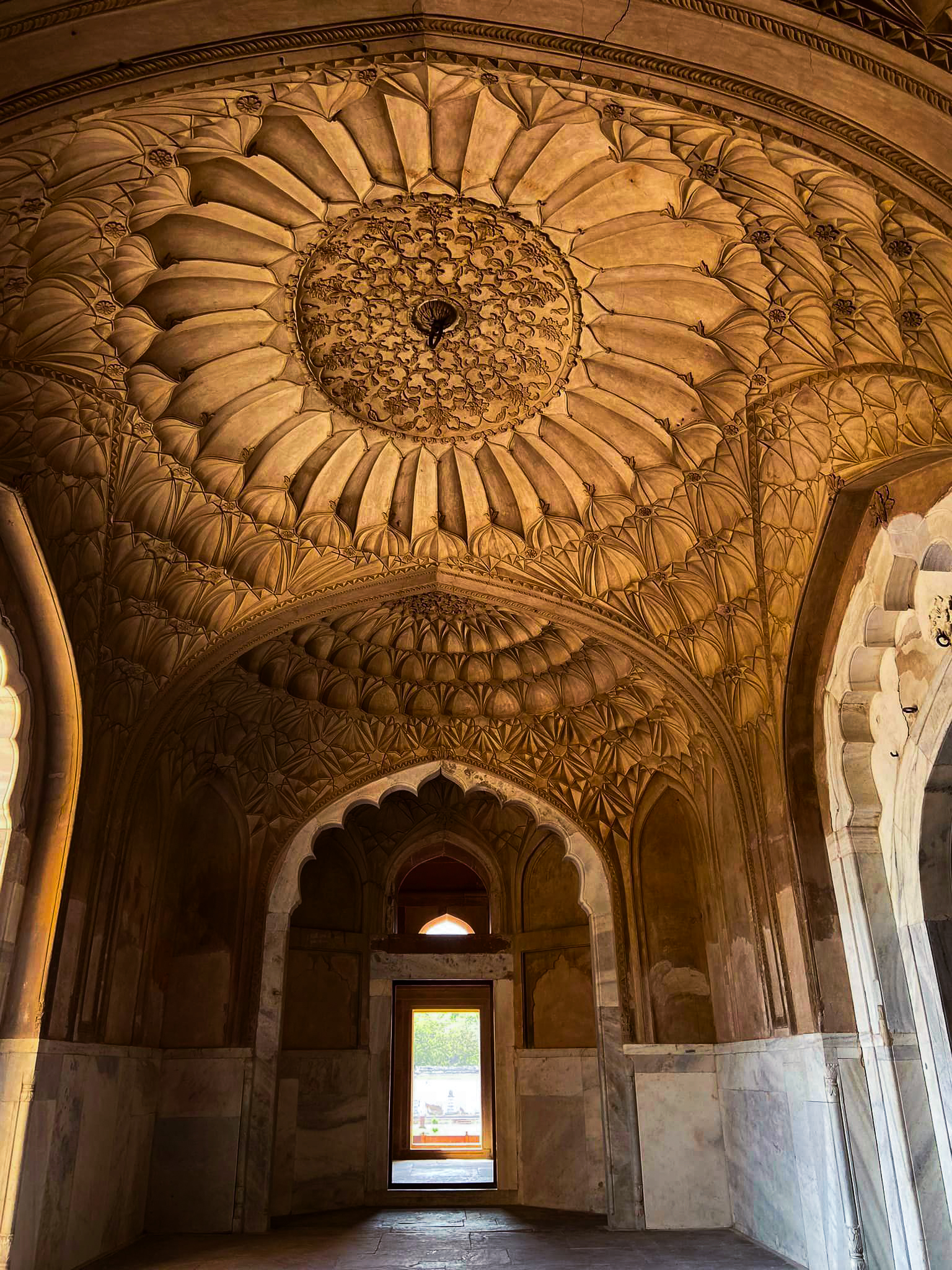Safdarjung Tomb is grandiose. Although it does not have the massive proportions of the more famous Humayun´s Tomb, it is a highly decorative monument that is set within a very lovely garden. Plus, its colour is simply gorgeous. A red sandstone finish imparts this tomb with a beautiful deep ochre and I am glad that insufficient funds deprived it of the originally planned all-over marble look. Built by the Nawab of Avadh, for his father, Safdarjang, this mid-18th-century tomb is one of my favourite examples of late-Mughal architecture. Personally, I call it a ´poor, rich Mughal monument´. It not only suffered the indignity of insufficient funds for an all-over marble finish but even its dome was completed with the materials taken from the nearby mausoleum of Khan-i-Khanan. In my eyes, it has a desolate look despite being extremely beautiful and this could be owing to its setting in a manicured garden with fountains that often remain dry.

Safdarjung Tomb
Table of Contents
Plagiarized design and pilfered materials?
Incidentally, Safdarjung Tomb is the last garden tomb constructed in the late Mughal Empire Style. It was built in the year 1754 and is the mausoleum of the Mughal statesman Mirza Muqim Abul Mansur Khan. He was popularly called Safdarjung and hence the name. Architecturally, this monument seems to draw inspiration from the more elaborate Humayun´s tomb, whereas, for its construction, materials from the tomb of Abdul Rahim Khankhana were used. Isn´t it ironic that such a popular and beautiful structure could have such a desolate story? First of all, its design seems to have been plagiarized, and then even its construction materials were pilfered from other monuments. At the time when Safdarjung tomb was built, the Mughal empire was in its decline and money was short. However, the proud dynasty still had the desire to keep up appearances even at the cost of shoddy materials. In short, Safdarjung Tomb was a desperate attempt to put on a show.
A tribute to a Mughal statement
However, don´t let this story of declining funds discourage you because poverty for the Mughals was like a king´s ransom for others. They still retained their inborn aesthetic sense and it can be clearly seen in the design of Safdarjung Tomb. An impressive double-storeyed entrance gate and a beautifully designed facade welcome one inside the complex. The intricate designs on the facade reminded me of the famous Season doors of City Palace in Jaipur although this one carries an Arabic inscription that says “When the hero of plain bravery departs from the transitory, may he become a resident of God’s paradise”. Interestingly, the back side of the facade houses several rooms and a library that are now closed to the public. Upon entering the complex, a huge square garden opens up and a path of fountains leads one directly to the monument. This beautiful garden measures 280 meters (920 ft) on each side with a courtyard and there is a three-domed mosque within the complex. The mausoleum stands on an elevated platform and from afar, it resembles the Taj Mahal. While the latter is famous for its perfect symmetry, Safdarjung Tomb looks slightly disproportionate and askew. Design-wise, it is quite uncomplicated. There is a square-shaped central chamber that contains a cenotaph and 8 partitions. Beautiful designs on Rococo plaster embellish the interior of the mausoleum and several intricate chattris have been thrown in for extra measure. The overall effect is humble yet pleasing; austere yet comforting. It seems to me to be the perfect final resting place for Safadrjung and his wife Amat Jahan Begum whose graves are placed in an underground chamber of the monument.

Mausoleum of Safdarjung Tomb
Safdarjung Tomb offers respite
The huge garden that surrounds the monument has many beautiful flowering, indigenous trees. In season, these become the favourite haunts of ruby-beaked parakeets, owls, falcons, hornbills, and hoopoes. Squirrels run riot here, fearless going about their business and on hot summer days, this garden with its gateways and pavilions seems to be the perfect place for a snooze. Even the cacophony of Delhi´s traffic seems to melt away there. Just imagine being surrounded by nothing but trees, a sultry breeze, a looming, lonely monument, and bird calls, and all you will want to do is put a handkerchief on your face and sleep. Pure respite!! After all, isn´t that what a mausoleum is supposed to do? Needless to say, I love the imperfect Safdarjung Tomb.
Safdarjung Tomb Travel Guide
How to Reach
It is located at the junction of Safdarjung Road and Aurobindo Marg (Road) in New Delhi near Safdarjung Airport. The closest metro station is Jor Bagh from where one can take autorickshaws or taxis to this attraction.
Opening Hours
It is open on all days of the week from 7:00 a.m. to 5:00 p.m. Skip the weekends to avoid crowds.
Entrance Fee
Indian: Rs 15, Foreign travellers: Rs 200, Photography: Free, Videography: An extra Rs 25
Other Tips
- Carry water and wear a hat in summer as there is little shade inside. Summers are very hot in Delhi.
- Wear comfortable walking shoes.
- Try to catch a sight of it in the evenings from 7:30 to 11 pm. Safdarjung Tomb is completely lit up and although visitors are not allowed inside, it still looks spectacular from the outside.
- Don´t forget to visit the nearby Lodhi Gardens.
- Head over to Khan Market for good food and better shopping.






Follow the rest of the Delhi series
- INDIA TRIP IN A NUTSHELL
- STREET ART IN DELHI
- DELHI GARDENS AND PARKS
- KHAORI BAOLI SPICE MARKET IN DELHI
- DELHI IN WINTER
- JAMA MASJID IN DELHI
- KATHPUTLI COLONY IN DELHI
- OUR WONDERFUL DELHI CITY STAY
- LODHI GARDENS, MY FAVOURITE DELHI PARK
RESPONSIBLE TRAVELING-BECAUSE I CARE

